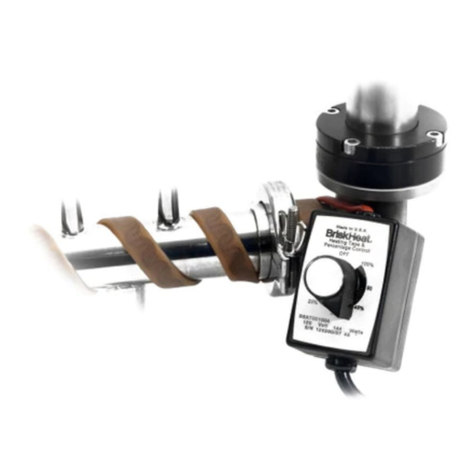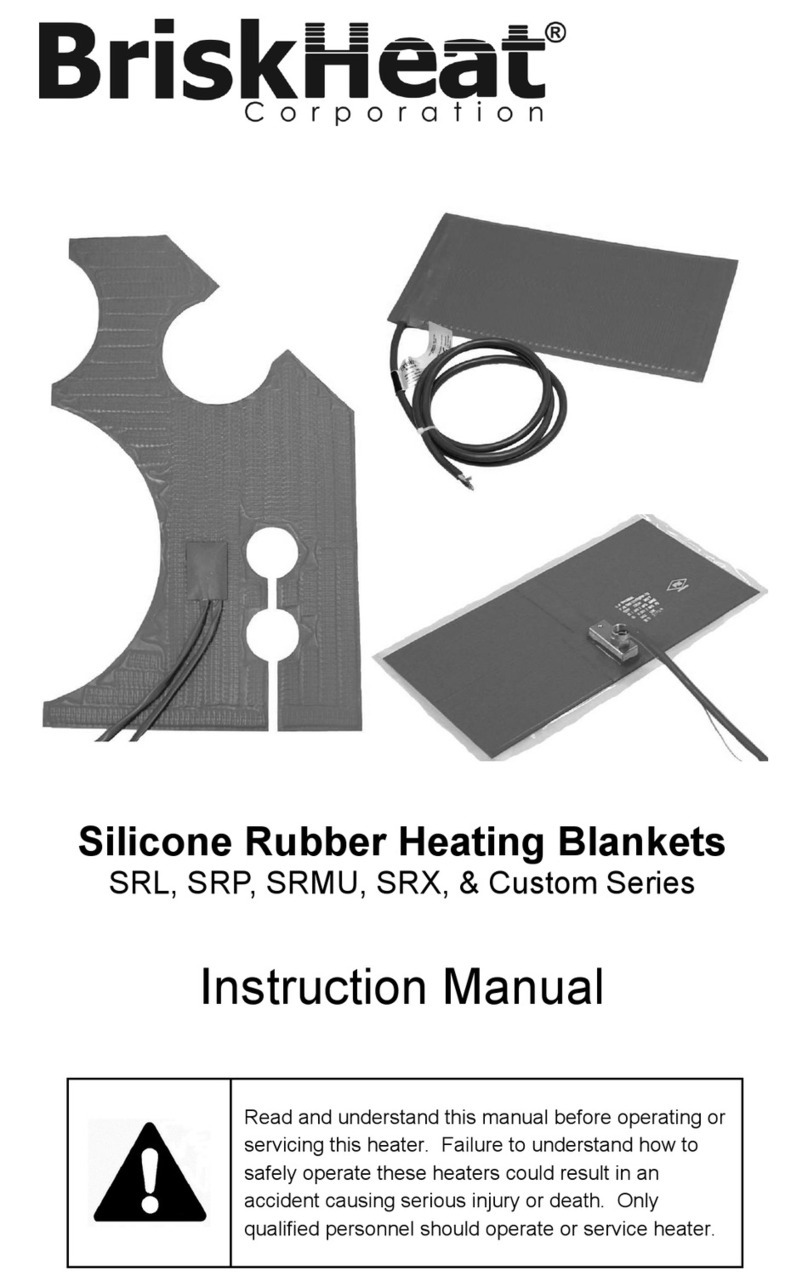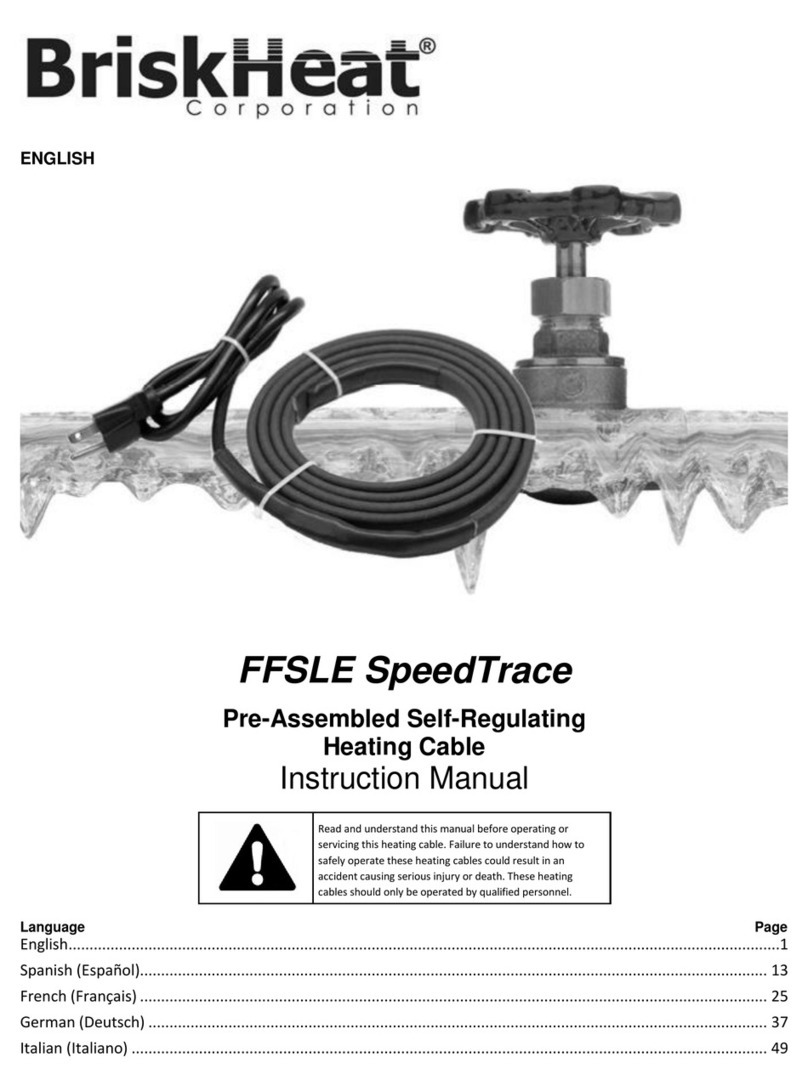
Self–Regulating Heating Cable
Installation & Maintenance
Instruction Manual
SAVE THESE INSTRUCTIONS!
Additional copies of this manual are available upon request.
You must read and understand this manual before installing, operating, or
servicing this product. Failure to understand these instructions could result
in an accident causing serious injury or death.
Keep these instructions for future reference.
Language Page
English ................................................................................................................................................................................................................................. 1
Spanish (Español) ............................................................................................................................................................................................................... 33
French (Français) ................................................................................................................................................................................................................ 65
German (Deutsch) .............................................................................................................................................................................................................. 97
Italian (Italiano) .................................................................................................................................................................................................................. 129
English
Self Regulating Heating Cable
© BriskHeat® Corporation. All rights reserved.
2
TABLE OF CONTENTS
IMPORTANT SAFETY INSTRUCTIONS ........................................................................................................................................................................... 3
PART INTENDED USE ...................................................................................................................................................................................................... 4
PART NUMBER MATRIX .................................................................................................................................................................................................. 4
TECHNICAL PARAMETERS ............................................................................................................................................................................................. 5
GENERAL INFORMATION ................................................................................................................................................................................................ 6
How Heating Systems Work ......................................................................................................................................................................................... 6
PRODUCT SELECTION .................................................................................................................................................................................................... 6
RECEIPT & STORAGE ..................................................................................................................................................................................................... 6
Receipt .......................................................................................................................................................................................................................... 6
Storage .......................................................................................................................................................................................................................... 6
INSTALLATION ................................................................................................................................................................................................................. 6
Scheduling .................................................................................................................................................................................................................... 7
Pre-Installation Check ................................................................................................................................................................................................... 7
Heater Handling ............................................................................................................................................................................................................ 7
Heating Cable Location ................................................................................................................................................................................................. 7
Straight Tracing ............................................................................................................................................................................................................. 7
Spiraling ........................................................................................................................................................................................................................ 8
Attachment .................................................................................................................................................................................................................... 8
Cutting the Heating Cable ............................................................................................................................................................................................. 8
Installation Details ......................................................................................................................................................................................................... 8
SYSTEM COMPONENTS ............................................................................................................................................................................................... 11
System Component Compatibility .............................................................................................................................................................................. 12
SLCBL Connection / Termination Kits ....................................................................................................................................................................... 13
SLCBL, SLMCBL, SLHCBL Connection / Termination Kits ....................................................................................................................................... 14
FM APPROVED SLCAB connection / termination kit ................................................................................................................................................. 15
FM APPROVED SLMCAB connection / termination kit .............................................................................................................................................. 15
CSA APPROVED SLCAB AND SLMCAB connection / termination kit ....................................................................................................................... 16
THERMAL INSULATION ................................................................................................................................................................................................. 17
Pre-Installation Checks ............................................................................................................................................................................................... 17
Installation ................................................................................................................................................................................................................... 17
Marking ....................................................................................................................................................................................................................... 17
THERMOSTATS & SENSORS ........................................................................................................................................................................................ 17
ELECTRICAL REQUIREMENTS ..................................................................................................................................................................................... 17
Voltage Rating............................................................................................................................................................................................................. 17
Electrical Loading ........................................................................................................................................................................................................ 18
Ground Fault Protection .............................................................................................................................................................................................. 24
Waterproofing .............................................................................................................................................................................................................. 24
TESTING ......................................................................................................................................................................................................................... 24
Recommendations ...................................................................................................................................................................................................... 24
Procedure .................................................................................................................................................................................................................... 24
START-UP ....................................................................................................................................................................................................................... 27
Heat-up Time .............................................................................................................................................................................................................. 27
Diversity Factor ........................................................................................................................................................................................................... 27
OPERATION & MAINTENANCE ..................................................................................................................................................................................... 27
System Design, Installation & Documentation ............................................................................................................................................................ 27
Preventive Maintenance.............................................................................................................................................................................................. 27
Visual Inspections ....................................................................................................................................................................................................... 27
Frequency ................................................................................................................................................................................................................... 27
Personnel Training ...................................................................................................................................................................................................... 27
Maintenance ................................................................................................................................................................................................................ 27
Piping Repairs ............................................................................................................................................................................................................. 27
DAMAGED PRODUCTS .................................................................................................................................................................................................. 28
TROUBLESHOOTING GUIDE ........................................................................................................................................................................................ 28
WARRANTY INFORMATION .......................................................................................................................................................................................... 32






























